
The Comdex Fall 2000 report
By MICHAEL TOMKINS
News Editor
Sunday, November 26, 2000
The Comdex Fall 2000 report!By Michael Tomkins, The Imaging Resource
(Sunday, November 26, 2000 - 21:27 EST)
Canon Inc.
Canon's digital offerings at Comdex included the popular EOS D30 digital SLR, PowerShot G1 and PowerShot S100 Digital ELPH cameras... The company also had a number of scanners and digital camcorders on display, although unfortunately Mike didn't get a chance to see these in any detail.Readers may be interested to know that all of the photos in this report are taken with the PowerShot G1, mostly at ISO 200 in Program mode, and occasionally with flash. Photos are taken at 1024 x 768 in high compression since they're later resized to 640 x 480 for web display. |
| 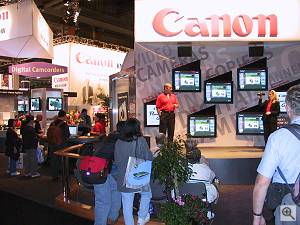 | | | 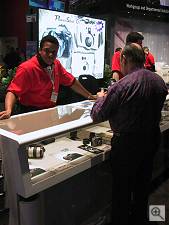 | | | Canon's digicams on display | |
|
Casio Computer Co. Ltd.
Casio's digital presence at Comdex consisted of the company's QV-3EXplus, QV-2300UXplus, QV-2800UXplus and QV-3000EXplus digital cameras. Interestingly, the company also had a case showing a wide range of 'digital camera accessories' including not just the usual rechargeable batteries and flash cards, but external flashes, tripods, cases, accessory lenses and more from third-party companies. |
|  | | | 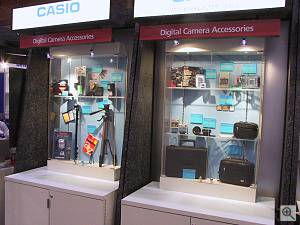 | 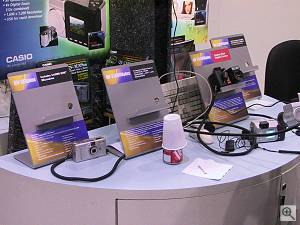 | | The 'Digital Camera Accessories' display | Casio's digicams on show |
|
Hewlett-Packard Co.
As well sa an array of printers/scanners, HP had an extremely compact display showing its range of PhotoSmart digital cameras, including the HP215, HP315, HP618 and HP912 (the last two of which are manufactured in cooperation with Pentax). |
|  | | | 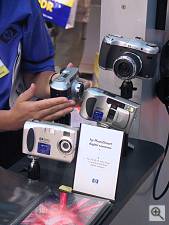 | | | HP's PhotoSmart digicams | |
|
Iomega Corp.
Iomega showed their FotoShow digital imaging set-top box, which our friends over at Steve's Digicams recently reviewed. |
| 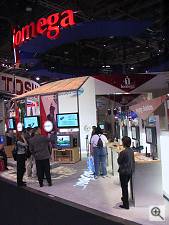 | | | 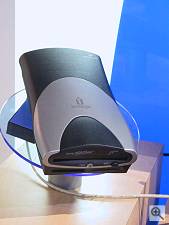 | | | Iomega's FotoShow set-top | |
|
Eastman Kodak Co.
Kodak's large booth showed off a range of digital cameras, both consumer and professional... A particularly interesting display showed the image sensors used in the DCS560 and DCS620 cameras alongside a wafer on which the sensors are produced, and the camera body/circuit boards used to make the final digital camera. The DCS Pro Back was also shown alongside its CCD sensor (terribly overexposed in our picture, but just visible - sorry!) Kodak also had a 'Solutions Pavilion' on their booth, highlighting third-party products allied with Kodak, such as image-editing software and the like. |
|  | | | 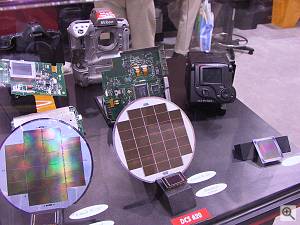 | 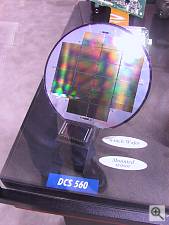 | | Pro digicams display | DCS560 wafer and mounted sensor | | | 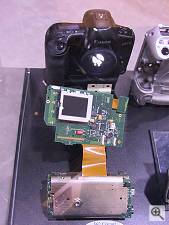 | 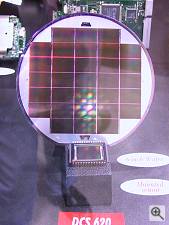 | | DCS560 - EOS 1N body and PCBs | DCS620 wafer and mounted sensor | | | 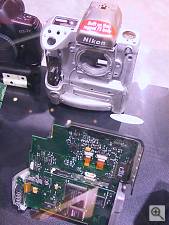 | 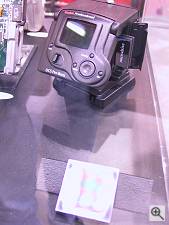 | | DCS620 - Nikon F5 body and PCBs | DCS Pro Back and mounted sensor | | |  | | | Consumer digicams display | |
|
Olympus America Inc.
Olympus' sizeable Comdex booth showed essentially the same digital cameras and photo printers shown at PhotoPlus Expo East in New York. |
| 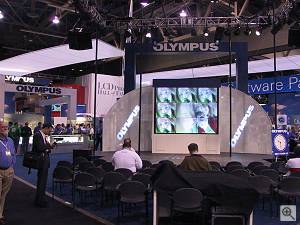 | | | 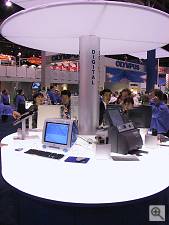 | 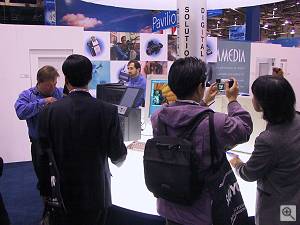 | | Olympus' photo printers on display | Olympus' latest digicams and printers hands-on |
|
Ricoh Corp.
Ricoh's PC Peripherals Business Unit concentrated on the recently announced RDC-i700, an interesting digital camera which also takes on some of the functionality of a handheld PC, with a large LCD touch screen display, Internet and fax capabilities, and the ability to email or FTP images directly from the camera. |
|  | | | 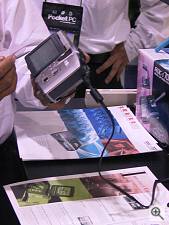 | 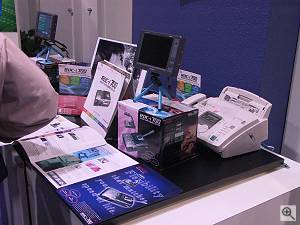 | | Ricoh's RDC-i700 digital camera in use | Ricoh's RDC-i700 digital camera display | | | 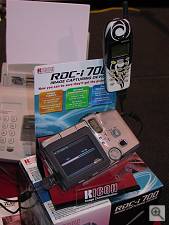 | 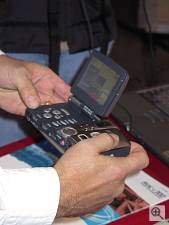 | | RDC-i700 close-up (taken at Digital Focus) | RDC-i700 in-hand (taken at Digital Focus) |
|
Samsung Co. Ltd.
Samsung showed three new digital cameras at Comdex... The SDC-80 features a 1/3" 850,000 pixel CCD image sensor, 1.8" LCD display, detacheable flash, and SmartMedia storage (4MB bundled). We'd speculate that the SDC-80 looks to be a replacement for Samsung's Digimax 800K, adding an LCD display and a more eye-catching design.Also shown was the SDC-130Z, which looks to be a redesign of the Digimax 130Z which we saw at PMA last February. The SDC-130Z retains the Digimax 130Z's 1/2.7" 1.3 megapixel CCD image sensor, 1.8" TFT LCD display, and 3x optical zoom lens, but again has a more eye-catching design and interestingly replaces the CompactFlash storage of the previous design with a SmartMedia slot. Finally, the SDC-200Z seems to have a similar feature set to the Digimax 210SE we saw last February, with a 1.8" TFT LCD display, 3x optical zoom lens and 2.11 megapixel CCD sensor, but again with CompactFlash storage swapped for SmartMedia, and a chassis redesign. |
|  | | | 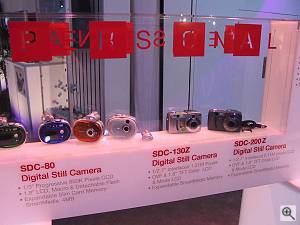 | 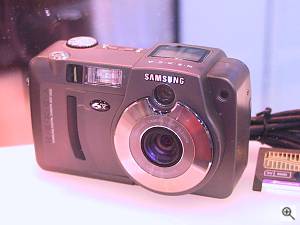 | | Samsung's digital camera display | Nexca SDC-200Z digital camera | | | 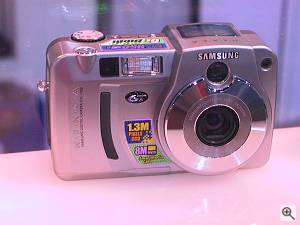 | 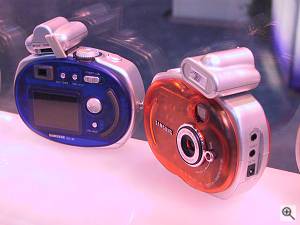 | | Nexca SDC-130Z digital camera | Nexca SDC-80 digital cameras | | | 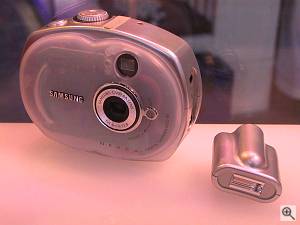 | | | Nexca SDC-80 close-up with flash detached | |
|
Sony Corp.
Whilst the majority of digital imaging interest from Sony Corp. was to be found on its MemoryStick pavilion and not in its main booth, we did spot a couple of items worth noting there too. First up, we again saw the Memory Stick Media Applications board that first appeared at a Japanese exhibition recently, noting future concept products based on the MemoryStick format. We also saw Sony's amazingly tiny working prototype digital still camera, which is billed as "the world's smallest digicam with an LCD display", and uses Memory Stick Duo cards for storage. Finally, we noted a display showing 128MB and 256MB MemorySticks - no word on when 256MB sticks will hit the market though. |
| 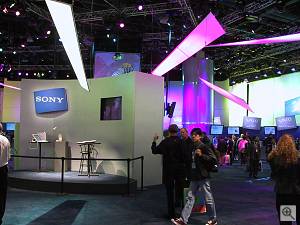 | | | 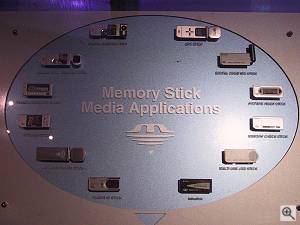 | 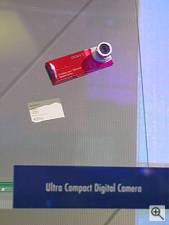 | | Mockups of future Memory Stick concepts | The world's smallest working digicam with LCD display | | |  | | | 64MB, 128MB and 256MB MemorySticks | |
|
|

Friday, November 17, 2000
ImageScape @ Comdex Fall 2000 report!By Michael Tomkins, The Imaging Resource
(Friday, November 17, 2000 - 20:05 EST)
The buzz word for this year's ImageScape, said Sony Electronics' Personal Network Solutions president Mark Viken in his keynote speech, was 'convergence' - the blurring of boundaries between what we currently perceive as three separate (if closely related) product groups, digital cameras, digital camcorders and mobile information appliances. Digital cameras are getting high resolution video capabilities, digital camcorders are improving their still image quality, and mobile information appliances (read: handheld computers, PDAs, notebook computers and even watches) are getting digital imaging capabilities, be they still, video, or in some cases both...
Perhaps an even more commonly used buzzword amongst those circulating around the room examining the latest offerings from numerous manufacturers was wireless, however. Flashpoint had their
Photivity wireless imaging solution on display at their booth, whilst rivals
Active Photo had their own solution which is apparently already in use by, amongst others, an insurance company for automatically transferring images from out in the field to a central location (both solutions shown above). We heard numerous comments on wireless imaging from attendees, exhibitors and ImageScape's panelists, with opinions basically belonging to one of two camps - either that the time for wireless is now, and that it has finally become feasible, or that the bandwidth necessary for wireless to be useable just isn't available, and that it is a case of manufacturers pushing technologies onto customers that they don't really need...
We'd have to take a middle ground on the issue ourselves - we can certainly see a place for wireless imaging in certain market segments such as insurance and the like, where speed with which photos can be examined and claims decided is most definitely important, but simultaneously we'd have to agree that with wireless technology limited at speeds of 14.4Kbps (the current maximum in mobile phone technology, we were told) wireless is not yet ready for the high-resolution images many of today's digital cameras produce.
Flashpoint's Photivity is based on the company's Digita operating system. A Digita-based camera connected to a mobile phone (Flashpoint were using Kodak's DC290 in their demonstration) allows for transfer of images, text or sound clips either to a web server which can be run by a third party, with APIs available to allow existing servers to be modified for use with the system. A Digita rep advised that image transfer times were in the order of 5 minutes per image... Active Photo's solution was based on a somewhat different model, where the company controlled the process end-to-end, providing not only the in-camera software but also the photo hosting as well. Again, images can be annotated with text and sound clips, and transferred to the host - no mention was made of emailing images from the camera however. Active Photo's system is currently in use, and they noted that they can customise the in-camera software to suit a customer's needs - for example to collect specific information along with each image. Pricing depends on image volume, and the company also expects as the price of cellular phones come down that they will make their service available to the public as well...
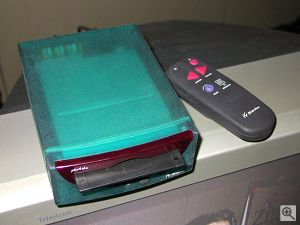
The next interesting device we spotted at ImageScape doesn't yet have a company to back it...
Photela's TV Slideshow is a TV set top box for displaying images, with a difference. The device, which features an infrared remote control for selecting and rotating images or starting an automatic slideshow of all images, is
not targetted at digital camera owners! Instead, Photela told us that they envision friends and relatives of digital camera owners, who are uninterested in the complications of digital photography, purchasing the set-top boxes at locations such as WalMart and K-Mart for the comparitively low price of $100. Images are loaded from a floppy disk, either directly from the camera if they are from a floppy-disk based camera such as Sony's Mavicas, or via Photela's PC program which optimizes the images for TV display (resizing them to 640 x 480 and compressing them at a variety of levels that allow from about 10-40 images per 1.44MB disk). Photela made a point of comparing the image quality of their device on a TV screen to that from the average digital camera's video output, noting that their set-top provides extremely clean images with no flickering or noticeable loss of quality... Images are preloaded into the unit's memory whilst the previous image is being viewed, so that there is minimal delay when switching from image to image. They are currently looking for a company to produce the TV Slideshow devices, and expect that they could be ready to manufacture them almost immediately.
Another interesting display at ImageScape (shown above) was a cooperation between
Raindrop Geomagic,
Arius 3D,
Z-Corp,
Viewpoint (formerly known as Metastream Corp.) and
NVidia. Arius 3D provide the hardware to capture a three dimensional "map" of the object along with texture information, which is then processed with Raindrop's Geomagic Studio 3.0 to create a 3D wireframe model and texture maps to overlay on the wireframe. Z-Corp provide the hardware to create a 3D model of the object out of either plaster or cellulose powder, which can then be infiltrated with wax or plastic resins to create a stronger model, and then "painted" with textures. Viewpoint provides the software for streaming the 3D models over the Internet, and NVidia the 3D graphics processing... We stopped by the booth and saw a computer model and a plaster model of a Pokemon character, which seemed very detailed indeed... Raindrop also took a photo of Mike which they promised to convert into a 3D model and email back, so hopefully once we receive it we can post it here as a demonstration. ;) When asked whether their process worked in a similar manner to the Metaflash 3D capture solution which we've talked about on the News page before, booth staff said that the process was similar, but had a much higher resolution 3D model... We were told that Raindrop's solution captured detail right down within a millimeter, to the point that it had been used by a cosmetics company to model facial wrinkles, and that competing solutions didn't look as detailed when the textures were removed. Unfortunately we weren't able to see this demonstrated at the booth, but images on Raindrop's website do show a high level of detail in the 3D mapping.
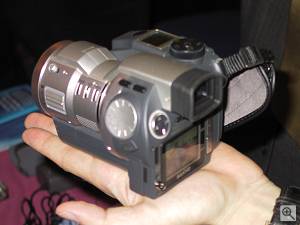
We did also see some new digital cameras at ImageScape... Perhaps the most interesting was from Sanyo, in the form of the IDC-1000Z 'iDshot' camera, which is the first camera using iD PHOTO disks to reach the market. The iDshot, which can store 730MB of images on each disk, did need a little explaining initially as the control layout was unlike any camera Mike had tried before, but once the Sanyo rep quickly explained it, it did make sense and was very simple to use... A dial on the top right of the camera is used to change modes (Record, Play, PC Connect, etc.), whilst the four-way rocker on the back of the camera is used for panning around images in playback, zooming in record mode, and selecting/changing items in the menus. In record mode, you can change aperture/shutter (dependent on the camera mode) by specifying which setting you want to change by pressing either of the buttons above the jog dial on the left side of the camera, and then spinning the jog dial to alter the setting. The camera seemed fairly fast in use, as born out by the specifications ofat least 7.5 frames per second in all resolutions, or 30 frames per second video, although many potential buyers may consider the 1.5 megapixel resolution and price tag of around $1500 to be show-stoppers... One thing we'd note is that the camera is smaller than the photos we've seen make it look, perhaps because we're conditioned to think of disk-based cameras as being fairly large, and the iD PHOTO disks are actually quite a bit smaller than their 3.5" magnetic brethren. ;)
Two other cameras we hadn't seen before were aimed at the lower end of the market were shown by Chicony and Ezonics. Chicony's TC800 digital camera has a megapixel image sensor and a design that features an optical viewfinder, built-in flash and LCD info display, but no LCD for reviewing images. The company had non-functional mockups of the camera on display, and plans to ship the camera at a price of $200. Further details were unavailable at the show... Ezonics, meanwhile, showed a camera which is apparently already shipping, but which we hadn't previously seen, the EZ Dual Cam. Similarly to the Chicony camera, the Dual Cam features an optical viewfinder, built-in flash and LCD info display, and no LCD for reviewing images, but the Ezonics design has a swiveling top portion on which the optical viewfinder, lens and flash are mounted, allowing them to be pointed independently of the camera body. The camera can also function as a webcam, and our guess is that this is the reason behind the swivel, which wouldn't be very functional in use as a still camera, but would allow for the lens to be pointed at the user for videoconferencing...

Tuesday, November 14, 2000
The Digital Focus @ Comdex Fall 2000 ReportBy Michael Tomkins, The Imaging Resource
(Tuesday, November 14, 2000 - 19:15 EST)

Digital Focus, an event held alongside the PC Expo, Fall Comdex and Fall PMA show each year, took place Sunday evening shortly after we arrived in Las Vegas. We attended, and whilst the majority of what we saw was beyond the scope of the Imaging Resource, or had already been shown previously at PhotoPlus Expo East in New York last week, we did see a number of new and interesting products which bear mentioning...
First off, we saw two interesting notebook computers from Fujitsu and Sony which featured digital cameras. Fujitsu's LifeBook (on the right) featured a digital camera which could be connected to the edge of the notebook' screen for recording video or low-resolution still images. More interesting, at least in Mike's personal opinion, was the Sony PictureBook C1VN, which was noteable both for the fact that the digital camera was built into the notebook's chassis as in previous PictureBooks, and also for its use of TransMeta's Crusoe processor.

The PictureBook C1VN (seen here on the left) is quite unusual in having a screen with an aspect ratio of about 15:7 (1024 x 480 pixels) which allows the screen size to be maximised whilst keeping the overall dimensions of the notebook to an absolute minimum, as determined by the size of the keyboard. TransMeta's Crusoe chip gives the C1VN a claimed battery life of 5.5 hours in a notebook that weighs 2.2 pounds. We noticed that the C1VN "Motion Eye" digital camera is labelled as providing improved image quality, but couldn't get a clarification from Sony as to exactly what had been improved. Initially, we were told that the camera had been upgraded to a megapixel sensor, but further checking revealed that it uses a 350K pixel progressive scan CCD image sensor which we believe is the same as the previous model (interestingly, our research found that the Japanese PCG-CX1E features a 410,000 pixel image sensor).
Next up was an interesting prototype on display from Kodak. We first told you about the company's tie-up with Sanyo to develop organic electroluminescent displays back on February 5th, 1999, and were interested to see a prototype display attached to a portable DVD player at Digital Focus. The display apparently uses significantly less power than an LCD display thanks to its self-luminous pixels which do not need a backlight. It also offers a greatly improved viewing angle which we've tried to demonstrate in the two pictures below - in both pictures, what you see on the Organic EL display is what was currently playing (scenes from the film Terminator, we think) - even viewed from these extreme angles, the Organic EL display is clear and easy to see, whereas in one picture the standard LCD display built into the DVD player isn't even visible. Pretty impressive stuff!
The next item of interest was Nikon's mighty-impressive AF-VR Nikkor 80-400mm 1:4.5-5.6D ED zoom lens... Without a doubt the most incredible lens Mike has ever laid hands on, Nikon's new baby was shown attached to the Nikon D1, and in a brief test of the lens at the booth, I found it a joy to use. The power of the zoom was, compared to anything I've had the opportunity to use before, simply stunning. The VR (Vibration Reduction) system worked like a dream, making it easy to handhold the lens without fear of blurring shots, but perhaps most impressive was the price, which should be in the region of $1700. If you've already spent the money on a D1 and are looking for a good tele lens to match it, definitely check this one out. The two photos below show the lens fully extended on the D1, and a closeup of the zoom ring and markings on the lens...
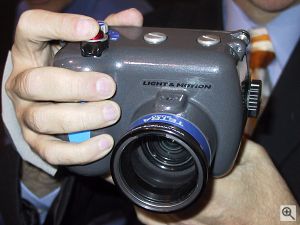
Finally, we noted that both Sony's DSC-P1 underwater housing and Light & Motion's Tetra 3030 underwater housing (see on the right) were on display at Digital Focus. We've shown you the DSC-P1 underwater housing in our review of the camera previously, but hadn't mentioned the Tetra 3030 before. With a depth rating of 300 feet and a cast aluminum build, the Tetra 3030 really feels the business! The housing has one other feature that Sony's version lacks - the ability to attach add-on lenses to the front of the housing. Why might you want to do this? Well, with a different density than air, water causes your lens to increase its effective focal length, meaning (in much the same way as with image sensor size variations) that wide-angle shots are more difficult to achieve. Screw in the optional multi-element wide-angle lens and you get that lost wide-angle capability back. Also available is an achromatic macro lens which allows for underwater macro photography with minimal chromatic abberation. Finally, we were also told that the Tetra 3030 also maintains near-neutral buoyancy (so you don't lose your camera to the depths should you drop it)!

